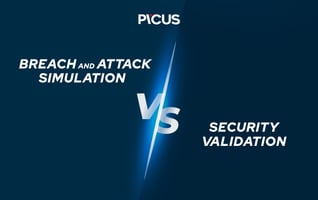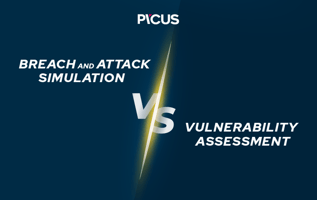Everything You Need To Know About BAS Tools
LAST UPDATED ON DECEMBER 13, 2024
What Are BAS Tools?
In this section, we define BAS tools, explain how they operate, and explore the attack scenarios and vectors they leverage to help organizations mitigate their risk posture.
Definition of Breach and Attack Simulation (BAS) Tools
In cybersecurity, a Breach and Attack Simulation (BAS) tool is a sophisticated, offensive, and automated software solution designed to safely and non-destructively simulate cyberattacks. These BAS security tools stress-test an organization's defensive mechanisms, identifying and validating exposures such as misconfigured security controls, software vulnerabilities, and weak security baselines.
How BAS Tools Work
BAS tools work by mimicking sophisticated adversaries, running a full attack kill chain within an organization's unique IT environment in a completely safe and non-destructive manner. They simulate a variety of attack scenarios, including:
- Network infiltration attacks
- Endpoint attacks
- Web application exploitation
- Email infiltration attacks
- Data exfiltration attacks
- URL filtering bypass attempts
These scenarios employ diverse attack vectors, including but not limited to:
- Malware and ransomware downloads
- Atomic attacks (e.g., credential dumping scenarios)
- Vulnerability exploitation
- Threat group and Advanced Persistent Threat (APT) simulations
By executing these attack vectors under different attack scenarios, BAS tools comprehensively evaluate the resilience of an organization's security architecture. This enables organizations to continuously optimize their defensive measures and proactively address vulnerabilities before they can be exploited by malicious actors.
How BAS Tools Help Mitigate Organizational Risks
BAS tools are integral to reducing organizational risks by ensuring that security controls effectively protect critical assets. While vulnerabilities may exist, not all translate into exploitable conditions for adversaries. For example, a properly configured NGFW or WAF can block the exploitation of specific vulnerabilities, preventing an attack from escalating and targeting sensitive assets.
However, gaps in security controls—such as misconfigurations or overlooked weaknesses—pose significant risks to an organization. These gaps can create pathways for adversaries to bypass defenses and access critical assets. Identifying and addressing such vulnerabilities is essential to minimizing risk exposure.
BAS tools excel in this area by simulating real-world attack scenarios to validate the effectiveness of existing security controls. They help organizations assess whether their defenses can protect key assets from potential threats, even under sophisticated attack methods. Through continuous validation and testing, BAS tools empower organizations to proactively close security gaps, strengthen their defenses, and safeguard their most valuable assets from exploitation.
Top 6 Breach and Attack Simulation (BAS) Tools Reviewed by Gartner
Gartner Peer Insights showcases reviews of the top Breach and Attack Simulation (BAS) tools based on user feedback, highlighting their capabilities in enhancing cybersecurity defenses [1]. The leading solutions are as follows:
- Picus Security
- Cymulate
- AttackIQ
- SafeBreach
- XM Cyber
- Pentera
These platforms enable organizations to simulate attack scenarios, assess the effectiveness of their security controls, and identify gaps in their defenses. For detailed, unbiased reviews of features like threat coverage, usability, and threat library comprehensiveness, users are encouraged to explore firsthand reviews and feedback from product users.
All Breach and Attack Simulation Tools Are Not Created Equal
All BAS tools are not designed the same.
While their overarching aim is to assess and enhance cybersecurity postures, differences arise in terms of their functionalities, threat libraries, and customization capabilities. An effective BAS tool offers comprehensive attack vector coverage, continuous and automated simulations, real-time threat updates, actionable mitigation suggestions, and integration with industry-standard frameworks like MITRE ATT&CK. It also allows for tailored threat creation, detailed reporting for diverse stakeholders, and seamless deployment across cloud and on-premises environments.
In the upcoming sections, we are going to list 9 important criteria to consider when buying a BAS Tool.
The Top 9 Criteria to Consider When Selecting a BAS Tool
When deciding on a BAS tool, several critical factors come into play.
1. Running Advanced and Comprehensive List of Attack Vectors
An attack vector is the pathway attackers use to gain unauthorized access to systems or networks. An effective BAS tool must validate a wide range of these vectors, tailored to an organization’s unique IT environment. By simulating real-world attacker tactics, techniques, and procedures (TTPs), BAS tools evaluate the effectiveness of security controls across key layers: network, endpoint, application, and data. This proactive approach helps organizations uncover vulnerabilities and strengthen their defenses against evolving threats—before it's too late.
Here are the some of the attack vectors that a BAS tool with good ROI must be able to test against:
-
Attack Scenarios: Simulating advanced adversarial behaviours (a.k.a TTPs used by threat groups / malware campaigns).
-
Data Exfiltration: Testing the ability to prevent or detect unauthorized transfer of organizational information.
-
Malicious Code: Simulating malware download attacks such as ransomware, info-stealers, backdoor installation, etc.
-
Lateral Movement: Identifying gaps for pivoting within an organization's internal networks.
-
Vulnerability Exploitation: Testing known and emerging vulnerabilities with publicly available PoC for exploitation.
-
URL Filtering: Assessing defenses against malicious or phishing URLs.
-
Web Applications: Simulating attacks on advanced web application vulnerabilities to test the effectiveness of implemented WAF solutions.
-
Endpoint Attacks: Testing the effectiveness of endpoint detection solutions like EDR, XDR, IDS, and SIEM.
-
Network Infiltration: Running malicious network traffic to non-destructively test the effectiveness of network-layer solutions such as NGFW, IPS, and others.
These capabilities help organizations uncover gaps in security controls and mitigate risks effectively.
Figure 1. Picus Security Validation Platform Running Wide Range of Attack Vectors
2. Up-to-date Threat Library for Known and Emerging Threats
The core motivation behind a BAS tool is to test how well the implemented security measures hold up against a real-life attack. For this reason, BAS vendors must provide an up-to-date threat library containing threats that mimic the latest adversarial behaviors observed in the wild.
This capability is especially important when a specific threat emerges, targeting a particular sector or region that aligns with your organization’s profile. If gaps in security controls are not identified and addressed promptly, organizations risk falling victim to highly targeted threat groups or malware campaigns.
|
For instance, on September 5th, 2024, FBI, CISA, and NSA released a joint advisory about the cyber activities of a Russian cyber unit known as GRU Unit 29155 (161st Specialist Training Center).
How did Picus Labs respond to this threat? In response to the CISA alert, Picus Labs promptly integrated this threat into its Threat Library within just two hours and created a ready-to-run, fully automated threat template for Unit 29155. The update included the group’s previously observed adversarial behaviors, vendor-specific mitigations, and a detailed blog post analyzing its TTPs. Users were also notified via platform pop-ups and email for immediate awareness. |
Figure 2. Russian GRU Unit 29155 Threat in Picus Threat Library
3. Validating Preventive and Detective Security Controls with a BAS Tool
A BAS tool should seamlessly integrate with a variety of preventive and detective security controls across an organization’s multi-layered defense architecture. The true value of BAS lies in its ability to continuously and automatically stress-test implemented measures, ensuring every gap is identified before an attacker can exploit it. To deliver a strong ROI, a BAS tool must effectively test a wide range of security measures, surpassing the capabilities of legacy and manual practices.
Below is a list of security controls whose effectiveness can be validated using the Picus Security Control Validation platform.
- Intrusion Prevention & Detection Systems (IPS & IDS)
- Next-Generation Firewall (NGFW)
- Web Application Firewall (WAF)
- Secure Web Gateway (SWG)
- Secure Email Gateway (SEG)
- Endpoint Detection and Response (EDR)
- Extended Detection and Response (XDR)
- Data Loss Prevention (DLP)
- Security Information and Event Management (SIEM)
As a figurative example, let’s refer to Figure 2. In this scenario, the Picus agent successfully breaches the NGFW and IPS, ultimately gaining access to the target agent within the network segment containing HQ endpoints. It’s worth highlighting that the platform supports both agent-based and agentless simulations, adapting seamlessly to the requirements of each simulation for optimal results.
Figure 3. Testing Enterprise Security Solutions with Picus Security Validation (SCV) Platform
4. Continuous and Automated Simulations with a BAS Tool
With today’s modern, complex IT infrastructure and cybercrimes reaching an all-time level of sophistication, manual assessment practices like penetration testing and red teaming cannot keep up. While they are valuable and complementary approaches that we still benefit from, they are typically performed only once or twice a year due to budget constraints and their human-centric, resource-intensive nature, which impacts the network and business operations.
Additionally, with the ever-evolving IT environment, including cloud integrations, remote working, and APIs, new exposures continuously emerge. These exposures can go unnoticed during the 6- or 12-month gaps between assessments, leaving systems vulnerable to adversaries, especially as new CVEs are discovered daily.
Figure 4. Continuously Testing Your Prevention and Detection Layer Solutions with a BAS Tool
For this reason, a BAS tool must deliver continuous and automated simulations for both known and emerging threats observed in the wild. This continuous testing capability ensures that vulnerabilities in security controls are identified and addressed promptly, using vendor-specific and neutral mitigation suggestions that have been pre-tested to confirm their effectiveness.
5. Creating Customized Threats with a BAS Tool
While a BAS tool excels at performing continuous and fully automated simulations without requiring manual intervention or an operator, it doesn’t mean the system is entirely hands-off or inflexible. There may be instances where you want to create and deploy your own custom threats to address specific scenarios or unique requirements.
Figure 5: Custom Threat Simulation with a BAS Tool – This figure, taken from Picus SCV, illustrates how a BAS tool allows users to create and execute customized threats to address specific organizational needs.
The Picus Security Control Validation platform empowers users to design custom threats tailored with specific payloads to target designated assets. As shown in Figure 6, the platform offers a wide range of attack actions, enabling users to simulate a Windows Endpoint Security attack. Additionally, it supports simulations for Linux and macOS endpoints, along with various other attack types, providing comprehensive testing capabilities.
Figure 6. Creating Customized Threats for Different Attack Modules with Picus BAS
For instance, in the figure given above, we are seeing that Picus Security Control Validation module which is powered by our cutting-edge BAS technology allows customization for all 6 attack domains;
- Network Infiltration
- Windows Endpoint Scenario
- Web Application
- E-mail Infiltration
- Data Exfiltration
- URL Filtering
to have a more solid and comprehensive visibility on their assets and security posture.
6. Actionable Vendor-based Mitigation
|
A BAS tool must not abandon users with the question, “What’s next?” No decision-maker ever thinks, “Oh great, our expensive security controls, which I’ve poured significant resources into, aren’t even fully protecting us from these costly threats. Now, what am I supposed to do with this information?” |
Simply knowing that your security posture falls short of expectations is only the first step. Without timely and effective remediation actions, you're not leveraging the full potential of your BAS tool. Once the assessment is complete, the BAS tool must provide actionable mitigation strategies—both vendor-specific and vendor-neutral—for the identified security gaps, ensuring a more streamlined and efficient response process.
|
Note that a BAS vendor’s mere claim of providing both vendor-specific and neutral mitigation suggestions is not enough.
The vendor must ensure that the mitigation signatures or suggestions actually work as intended. This is crucial because many security teams, for instance, struggle with unvalidated outputs from Sigma rule converters. At Picus, we have a dedicated sub-team within our blue team that thoroughly researches and validates these suggestions before adding them to our mitigation library. |
For example, as of the date of this blog post, the Redline Infostealer was gaining traction globally.
Recognizing the potential repercussions on assets that hadn't been validated or adequately protected, Picus Labs promptly incorporated the attack simulation into the Picus Threat Library. Subsequently, 34 mitigation signatures from seven distinct vendors were introduced to fend off a potential attack if encountered.
Figure 7. Mitigation Suggestions for the Redline Infostealer by Picus BAS Tool
To see the vendor-based mitigations, click here.
7. Real-Time and Customized Reporting
An exhaustive security assessment generates a significant amount of information, which must be shared with various stakeholders in an organization. Therefore, a BAS tool should effectively communicate its results through assessment reports tailored to diverse audiences, including executives, SOC teams, and auditors.
Figure 8. Simulation Results Charts with Picus BAS Tool
These reports need to be detailed, providing a clear and comprehensive view of the security landscape. They should showcase metrics such as the overall security score, which offers a general assessment of the system's security health.
The detection rate, which illustrates how effectively threats are identified, is crucial. Additionally, the mean time to detect (MTTD) provides insight into the system's responsiveness. Trend statistics are valuable for understanding patterns over time. Metrics such as log collection reveal system activity levels, while detection and prevention statistics highlight the system's protective measures.
Finally, the inclusion of compliance-related data ensures that regulatory benchmarks are being met, adding another layer of accountability and assurance.
8. Mapping to MITRE ATT&CK and Other Industrial Frameworks
The MITRE ATT&CK framework is a widely accepted standard that cybersecurity experts use to outline the strategies and techniques of cyber adversaries.
Organizations commonly use heatmaps to visualize their defenses against these strategies. A top-tier BAS tool should automatically align its simulated threats and results with the MITRE ATT&CK framework. This alignment ensures that simulated attack methods and any highlighted security weaknesses are contextualized according to this industry-standard reference, making it easier for security teams to understand and address potential vulnerabilities.
Figure 9. MITRE ATT&CK Mapping of the Simulated Threats by Picus Security Validation Platform
For example, in the figure above, an arbitrary host has run numerous simulations, each including various threats. These threats contain specific attack actions, which are mapped to the MITRE ATT&CK framework. Out of 1,562 attack actions executed, the host successfully blocked (prevented) 944 of them. However, only 25% of the non-blocked actions were logged and alerted.
With this statistical visibility, organizations can identify the specific steps in the attack kill chain where they lack resilience. This enables them to initiate actionable mitigation and remediation processes to address vulnerabilities in both preventive and defensive security layers.
9. Ease of Use and Ease of Deployment
In the complex landscape of modern cybersecurity systems, enterprises rely on a wide range of security tools, with some deployed in the cloud and others on-premises. Managing these tools can be resource-intensive, requiring significant time and expertise from SOC teams.
A well-designed BAS tool should:
-
Feature an intuitive, user-friendly dashboard to make navigation straightforward and reduce learning curves.
-
Avoid adding unnecessary complications, ensuring it does not burden the existing workload of the team.
-
Streamline the refinement of security measures, helping teams address vulnerabilities efficiently.
-
Enhance the productivity of security personnel, allowing them to achieve more with minimal effort and strain.
-
Seamlessly integrate into existing infrastructures, avoiding disruptions while complementing pre-established workflows.
-
Provide flexible deployment options, supporting both cloud-based and on-premises environments to suit diverse organizational needs.
These capabilities ensure that a BAS tool not only strengthens security but also simplifies operations for security teams, maximizing efficiency without additional strain.
Top 7 Open Source BAS Tools & Their Limitations
Figure 10. Open-Source BAS Tool Comparison
MITRE Caldera
MITRE Caldera offers a sophisticated emulation of cyber threats, giving users the capability to autonomously emulate red team engagements and customize adversary scenarios. What sets Caldera apart is its comprehensive coverage of ATT&CK techniques, making it a preferred choice for organizations leaning heavily on the MITRE framework.
Drawbacks:
-
Complexity: Caldera is intricate, requiring operators with a deeper understanding to effectively utilize its capabilities.
-
Post-Compromise Emphasis: While it's comprehensive, Caldera's primary focus remains on post-compromise techniques, potentially leaving some pre-compromise vectors less explored.
Atomic Red Team
Atomic Red Team is designed for granularity, allowing security teams to focus on specific ATT&CK techniques and test them individually or in chained sequences. It's a favorite in the community, owing to its comprehensive atomic test library.
Drawbacks:
-
Automation Lacking: Its default setup does not automatically run tests, which means manually triggering each test, potentially reducing efficiency.
-
Limited Scenario Emulation: Individual tests may not capture the complexity of real-world attack chains unless manually strung together by operators.
Infection Monkey
Guardicore's Infection Monkey is renowned for its aggressive breach simulations, focusing on lateral movement across networks. It operates more like a rampant monkey than a stealthy adversary, which is both its strength and its limitation.
Drawbacks:
-
Noise Generation: Infection Monkey is aggressive and can create significant noise during simulations, which isn't representative of sophisticated, stealthy adversaries.
-
Unpredictable Emulations: Its modus operandi, while thorough, may not align with specific scenarios organizations want to test, given its rampant approach.
Stratus Red Team
Stratus Red Team fills a niche in the open-source space, offering emulation tools explicitly tailored for cloud environments. Its unique focus on cloud-based threats makes it a go-to for businesses heavily invested in cloud infrastructure.
Drawbacks:
-
Limited Scope: Being cloud-specific, it doesn't address threats in non-cloud environments, potentially leaving gaps in holistic security assessments.
-
Narrow Emulation Range: It doesn't cover the full spectrum of threats, focusing primarily on cloud-based attacks.
Honorable Mentions:
DumpsterFire:
-
Outdated Scenarios: Many of its test scenarios were created years ago and might not fully represent the current threat landscape, potentially missing new and emerging threats.
Metta:
-
Limited Updates: With no significant updates since 2018, its library lacks newer adversary techniques, making it less relevant for today's threat landscape.
Red Team Automation (RTA):
-
Maintenance Concerns: It hasn't been updated or maintained since 2018, raising concerns about its relevance and effectiveness against modern threats.
Conclusion:
Open-source adversary emulation tools, while valuable, come with their set of challenges.
Organizations must be aware of these limitations to ensure they get a comprehensive view of their security posture. When relying on these tools, it's crucial to supplement them with up-to-date threat intelligence and possibly consider combining them with other tools or enterprise solutions to fill in the gaps.
In the following section, we are going to examine how Picus’ Security Control Validation platform addresses the limitations and challenges listed to provide a better RIO practice of BAS assessments.
Picus Security Validation Platform as a BAS Tool
Picus Security Control Validation, powered by our award-winning Breach and Attack Simulation technology, helps you to measure and strengthen cyber resilience by automatically and continuously testing the effectiveness of your security tools.
Picus is renowned for its comprehensive and up-to-date threat library, which is actively updated daily by offensive security experts to ensure defenses can be proactively tested against current and emerging attack strategies. This extensive library empowers organizations to simulate real-world threats with precision and stay ahead of adversaries in the ever-evolving cyber landscape.
In order to provide a user-friendly experience, the Picus SCV offers its customers ready-to-run attack simulations. These simulations are equipped with a single threat or multiple threats which are stored in our comprehensive and up-to-date threat library.
Figure 11. Ready-to-Run Attack Templates in the Picus Security Validation Platform with a BAS Tool
How does the library get updated?
Our dedicated Picus Labs team conducts continuous and in-depth threat intelligence research to stay ahead of evolving threats. This research covers a broad spectrum, including:
-
Malware campaigns such as malware downloaders, info-stealers, and ransomware.
-
Emerging threats announced through joint efforts by organizations like CISA, FBI, and NSA.
-
Threat group activities and Advanced Persistent Threat (APT) campaigns.
-
Exploitation attacks, including zero-day vulnerabilities with publicly available Proof-of-Concepts (PoCs).
This proactive approach ensures comprehensive coverage of the latest adversarial tactics and techniques, enabling organizations to enhance their defenses effectively.
By analyzing malware samples and behaviors observed in the wild, our engineers continuously update the Picus Threat Library with new threats. Each attack action is rigorously tested to ensure it does not compromise the testing environment. This allows organizations to assess their readiness against these threats confidently, eliminating assumptions and enabling direct validation of their security controls' effectiveness.
With every new threat added to the library, Picus also provides corresponding vendor-specific and vendor-neutral mitigation suggestions—one of the key features for which Picus is best known. These mitigations are particularly critical when vulnerabilities are actively exploited by threat actors. In scenarios where patches are unavailable or impractical to implement immediately, these mitigation strategies become invaluable. They allow security teams to manage risks effectively by understanding the nature of the attack, applying temporary fixes, or delaying disruptive patching efforts through configuration adjustments, ensuring continued operational stability while addressing the threat (you will see more about this in the case study below).
Armed with visibility into security infrastructure gaps and actionable, quick-to-deploy vendor-based mitigations, organizations are better prepared to defend against both emerging and known threats.
Step-by-Step Case Study: Running a BAS Simulation with Picus
To provide a solid understanding of how Picus Security Validation is powered by BAS capabilities, let’s examine an example. Imagine we created a simulation designed to test both our prevention and detection layer solutions against the latest malware campaigns observed in the wild.
Step 1: Choosing the Threats from Picus Threat Library
For this simulation, we collected 247 different threats active in 2024, each containing various attack actions, as illustrated in the figure.
Figure 12. Arbitrary Attack Simulation Based on the Picus Threat Library
After completing the necessary setup steps and defining the simulation schedule, the simulation process begins.
Step 2: Analyzing the BAS Simulation Reports
Once the simulation is complete, users are presented with an intuitive dashboard that clearly displays the results. This is accompanied by an in-depth analysis provided in a comprehensive report. The report ensures not only that simulated threats are being blocked but also that secondary defense layers, such as SIEM platforms, are effectively detecting, logging, and alerting on any threats that may have bypassed the initial preventive measures.
For instance, our detailed reports provide metrics on the performance of both detection and prevention layer solutions during an attack scenario.
To illustrate, consider Figure 13: out of 247 simulated threats, 139 were successfully blocked. However, the remaining 99 (some of which couldn’t be tested) managed to bypass defenses and reach the location of our agent.
Figure 13. Prevention Simulation Results with Picus BAS
On the other hand, we can also determine whether threats that couldn’t be blocked were properly logged and alerted. This provides valuable insights for SOC teams, helping them evaluate the effectiveness of incident management processes under real-life stress-testing conditions.
Figure 14. Detection Simulation Results with Picus BAS
The success of an attack is determined by whether any individual attack action within the threat reaches the Picus agent. If even one action penetrates the defenses, the entire attack is classified as successful. In the case of the 99 threats that bypassed the defenses, the detection layer solutions were only 62% effective. This highlights a significant gap and underscores the need for targeted refinements in SIEM configurations to enhance detection and logging accuracy.
For instance, consider Figure 13. The Toneshell backdoor malware, used by the Mustang Panda threat group, successfully breached the defenses. However, despite the attack not being prevented, we can see that two of the implemented SIEM solutions on an arbitrary host successfully logged and alerted the breached threats.
Figure 15. Mustang Panda’s Toneshell Backdoor Malware Not Being Prevented
Step 3: Applying Ready-to-Implement Mitigation Suggestions
Apart from our up-to-date threat library, Picus is also best known for providing both vendor-specific and vendor-neutral mitigation suggestions tailored to address gaps in prevention and detection layers. By delivering actionable insights, Picus helps security teams enhance their cyber resilience, optimize their technology investments, and significantly reduce the risk of breaches. This dual-layered approach ensures that organizations are equipped with the tools and knowledge to defend against even the most sophisticated attacks.
Having visibility into the security gaps against the Toneshell backdoor, organizations can apply the vendor-based mitigation suggestions that the Picus SCV provides.
Figure 16. Vendor-Based Mitigation Suggestions for the Threats That Weren't Blocked
In Figure 16, Picus Labs demonstrates how it integrates mitigation recommendations from distinct vendors, enabling customers to swiftly strengthen their prevention layer solutions against potential malware and malware downloader attacks.
In summary, the Picus Security Validation module serves as a cornerstone of cyber resilience in today’s volatile digital environment. Leveraging advanced Breach and Attack Simulation technology, it empowers organizations to proactively identify vulnerabilities and respond effectively.
The Picus Security Validation Platform’s dedication to real-time updates, comprehensive threat intelligence, and actionable mitigation solutions delivers a high return on investment. By continuously refining and simulating threat scenarios, Picus ensures organizations remain ahead of adversaries, with defenses that are both robust and adaptive. As cybersecurity evolves, a proactive approach is no longer optional—it’s essential. Picus exemplifies this philosophy, seamlessly bridging the gap between insight and actionable defense.
Pricing for Picus Breach and Attack Simulation (BAS) Tool
Pricing for BAS tools can adapt to the specific needs of an organization, allowing for tailored solutions based on selected functionalities. For example, organizations focusing on ransomware readiness can choose a package designed to assess their defenses against ransomware threats. Similarly, businesses seeking to enhance endpoint security can include prevention and mitigation content, or expand their scope by adding detection analytics for SIEM or EDR systems. This flexibility ensures that companies pay for the capabilities most relevant to their security priorities and operational needs, making the solution scalable and efficient.
This flexibility ensures that companies pay for the capabilities most relevant to their security priorities and operational needs, making the solution scalable and efficient.
The Future of BAS Tools
BAS 2.0 and Adversarial Exposure Validation (AEV)
Breach and Attack Simulation (BAS) tools have been a cornerstone of cybersecurity strategies, enabling organizations to validate the effectiveness of their security controls by simulating attacker tactics. Recently, the cybersecurity market has redefined the categorization of BAS tools, placing them under the broader umbrella of Adversarial Exposure Validation (AEV), as recognized by Gartner. This terminology highlights their pivotal role in identifying and validating exposures across IT environments.
AEV technologies encompass both BAS tools and Automated Penetration Testing (& Attack Path Mapping), and Red Teaming technologies, as illustrated in the diagram. While BAS tools remain essential for emulating real-world attacker behaviors, the broader AEV framework reflects their expanded application in exposure validation and continuous risk assessment. This evolution is also referred to by some as "BAS 2.0," emphasizing the strategic importance of these tools in modern exposure management programs.
By simulating attacks and assessing potential risks, BAS tools within the AEV category empower organizations to prioritize vulnerabilities effectively and align their defenses with the ever-changing threat landscape. This integration underscores their critical role in managing and mitigating risks in a more dynamic and holistic way.
Conclusion
Recap of the Importance and Benefits of BAS Tools
Breach and Attack Simulation (BAS) tools are a cornerstone of modern cybersecurity practices, enabling organizations to proactively identify vulnerabilities, validate the effectiveness of their security controls, and reduce their risk posture. By emulating and simulating real-world attack scenarios, these tools provide continuous, automated, and non-destructive testing, ensuring that organizations can stay ahead of ever-evolving threats. Key benefits of BAS tools include comprehensive security assessments, actionable mitigation recommendations, and alignment with industry frameworks like MITRE ATT&CK, which help organizations bolster both preventive and detective security layers.
With capabilities such as up-to-date threat libraries, customized threat simulations, and robust reporting, BAS tools not only enhance the resilience of security measures but also streamline decision-making for IT and security teams. Their integration with existing infrastructures, along with flexible deployment options, makes them indispensable for organizations aiming to achieve a proactive and adaptive cybersecurity posture.
Final Thoughts on Choosing and Implementing BAS Solutions
When selecting a BAS tool, organizations must prioritize solutions that offer continuous and automated testing, actionable insights, and seamless integration with their security architecture. Tools like the Picus Security Control Validation platform set the benchmark by combining a comprehensive threat library, vendor-specific mitigations, and real-time updates to ensure organizations are prepared for emerging threats. Additionally, ease of use, flexible deployment options, and tailored reporting make these tools accessible and effective for diverse teams across various industries.
Implementing BAS solutions is not just about filling gaps in security but fostering a proactive approach to cybersecurity. By continuously validating and optimizing defenses, organizations can mitigate risks, improve compliance, and ensure their critical assets remain protected. In an era where cyber threats are more sophisticated than ever, investing in a robust BAS tool is a strategic necessity, empowering organizations to stay resilient and secure in an increasingly digital world.








